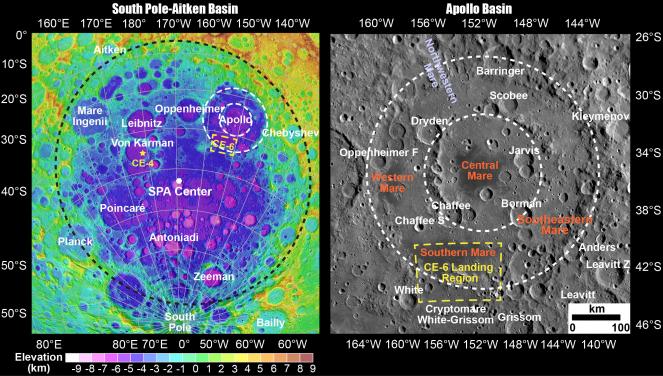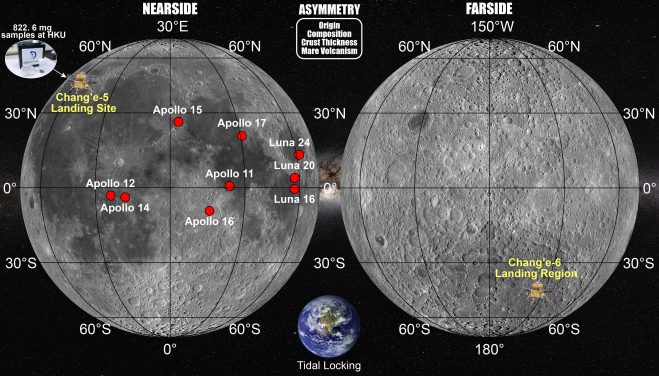Media
HKU Geologists Reveal Mysterious and Diverse Volcanism in Lunar Apollo Basin, Chang'e-6 Landing Site
07 May 2024

Chang’e-6 landing site is located to the Apollo basin in the northeast of the South Pole-Aitken basin. (Image credit: Dr Yuqi Qian)

Chang’e-6 mission is the world’s first lunar farside sample return mission. (Image credit: Dr Yuqi Qian)
- 1 / 2
- 2 / 2
The farside of the Moon is a mysterious place that is never visible from the Earth. The most remarkable feature of the Moon is its asymmetry between the lunar nearside and farside in composition, crust thickness, and mare volcanism. Scientists have not yet reached a consensus on the origin of the lunar asymmetry due to the lack of farside samples, which is one of the most significant remaining question of lunar science. Chang’e-6 mission, launched on May 3, 2024, currently heading to the Moon, is the world’s first lunar farside sample-return mission. It aims to return ~2 kg lunar soils to the Earth from the southern mare plain of the Apollo basin within the South Pole-Aitken basin, the largest impact feature in the Solar System. These samples contain enormous scientific potentials that can be used to solve the lunar dichotomy conundrum and even reshape human’s knowledge of our closest neighbour.
As shown in the recent paper published in Earth and Planetary Science Letters, Dr Yuqi QIAN, Professors Joseph MICHALSKI and Guochun ZHAO from the Department of Earth Sciences at The University of Hong Kong (HKU) and their international collaborators have comprehensively studied the volcanism of the Apollo basin and its surroundings, which revealed the mysterious and diverse volcanism of the Chang’e-6 landing site with significant implications for the Chang’e-6 sample analysis and the origin of the lunar dichotomy.
The study has found that the Apollo basin has extensive volcanic activities lasting from the Nectarian (~4.05 billion years ago) to the Eratosthenian Period (~1.79 billion years ago). Volcanic activity in the region was significantly influenced by crustal thickness. Dikes in intermediate-thickness crust tend to stall beneath the crater floor, spreading laterally to form a sill and floor-fractured crater. Dikes below the crust thinned by the Apollo basin event reached directly to the surface and erupted to form widespread lava flows, and dikes in thick crust stall before being able to reach the surface and form basaltic dike intrusions. "This fundamental finding indicates that the crustal thickness discrepancy between nearside and farside may be the primary cause of lunar asymmetrical volcanism," said Dr Qian. "This can be tested by the returned Chang’e-6 samples."
For the southern mare plain in the Apollo basin, where Chang’e-6 is going to land, there are at least two episodes of eruptions. The earlier one erupted ~3.34 billion years ago with low-Ti composition and covered the entire topographically low region between the Apollo peak ring and basin rim. The later eruption occurred ~3.07 billion years ago with high-Ti composition close to Chaffee S crater and flowed east with decreasing thickness until encountering proto-wrinkle ridges. The authors suggested the high-Ti basalts in the west have the most abundant scientific meanings. Sampling it would return high-Ti basalts, underlying low-Ti basalts and exotic nonmare materials that were transported by impact events. Professor Michalski emphasised: "Diverse sample sources would provide important insights into solving a series of lunar scientific questions hidden in the Apollo basin."
"The result of our research is a great contribution to the Chang’e-6 lunar mission. It sets a geological framework for completely understanding the soon-returned Chang’e-6 samples and will be a key reference for the upcoming sample analysis for Chinese scientists," said Professor Guochun Zhao, Chair Professor of HKU Department of Earth Sciences and the co-author of the paper. "It moves a large step for HKU when the university seeks excellence in planetary sciences and more participation in the national space programme."
HKU is the only university in Hong Kong that possesses lunar samples obtained by the Chang’e-5 mission from nearside. Building on the foundation of this work, the geological team from HKU will also pursue the opportunity to acquire Chang’e-6 samples as well. This initiative aims to enable HKU to possess lunar samples representing both nearside and farside, thus unlocking a new window of scientific exploration into the study of two lunar hemispheres.
The journal paper can be accessed here: https://doi.org/10.1016/j.epsl.2024.118737
About Dr Yuqi Qian
A planetary geologist from the Department of Earth Sciences and Laboratory for Space Research at HKU. He collaborated with colleagues from Mainland China and around the world to study alien worlds. His research focuses on the geological processes of the Moon based on the data and samples obtained by China’s Lunar Exploration Program and other nations.
For more information about Dr Yuqi Qian, please visit: https://yuqiqian.com.
About Professor Joseph Michalski
Utilising a range of remote sensing data, including infrared, visible, magnetic, gravity, and laser data from satellites orbiting Mars and rovers on its surface, Professor Michalski and his team at HKU focus on uncovering new discoveries about the volcanology, geochemistry, tectonics, and mineralogy of Mars. He has established the Planetary Spectroscopy and Mineralogy Laboratory at HKU. This cutting-edge facility offers laboratory support for past, current, and future missions to Mars, the Moon, and asteroids in China and beyond. Professor Michalski also serves as Deputy Director of HKU's Laboratory for Space Research.
For more information about Professor Michalski, please visit: https://joeplanets.com.
About Professor Guochun Zhao
Professor Zhao is a highly esteemed geologist with international recognition, specializing in metamorphic petrology, Precambrian geology, and supercontinents. His extensive contributions to the field include over 400 scientific papers with more than 68,000 citations, earning him prestigious accolades. He was elected as a member of Chinese Academy of Sciences in 2019, a fellow of the World Academy of Sciences for the Advancement of Science in Developing Countries in 2021, and a member of Hong Kong Academy of Sciences in 2023. In the 2024 Best Scientists Rankings, compiled by Research.com, Professor Zhao stands 8th in the world and 1st in China in Earth Sciences.
For media enquiries, please contact Ms Casey To, External Relations Officer (Tel: 3917 4948; Email: caseyto@hku.hk / Ms Cindy Chan, Assistant Director of Communications of HKU Faculty of Science (Tel: 3917 5286; Email: cindycst@hku.hk).
Image download and caption: https://www.scifac.hku.hk/press
